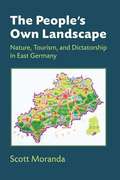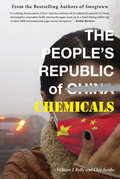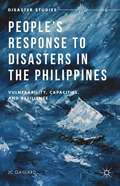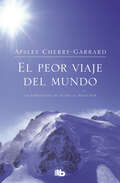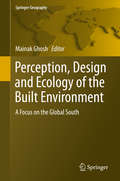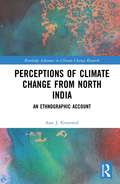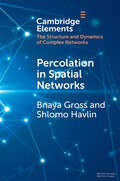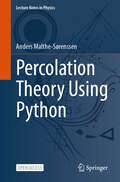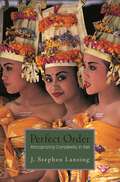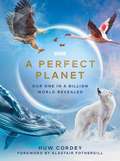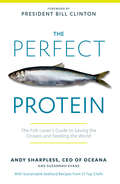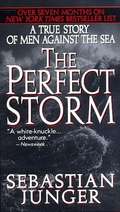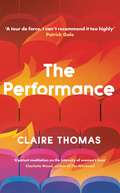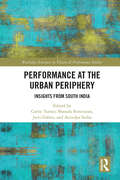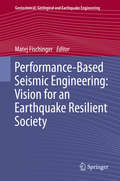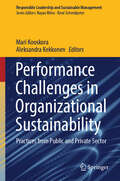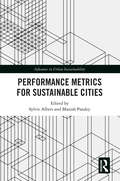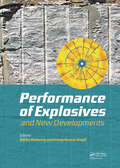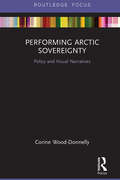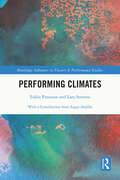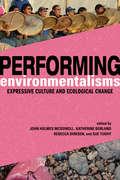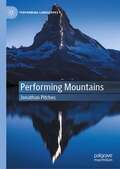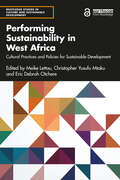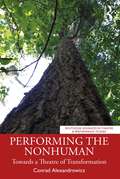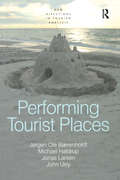- Table View
- List View
The People's Own Landscape: Nature, Tourism, And Dictatorship In East Germany
by Scott MorandaEast Germany’s Socialist Unity Party aimed to placate a public well aware of the higher standards of living enjoyed elsewhere by encouraging them to participate in outdoor activities and take vacations in the countryside. Scott Moranda considers East Germany’s rural landscapes from the perspective of both technical experts (landscape architects, biologists, and physicians) who hoped to dictate how vacationers interacted with nature, and the vacationers themselves, whose outdoor experience shaped their understanding of environmental change. As authorities eliminated traditional tourist and nature conservation organizations, dissident conservationists demanded better protection of natural spaces. At the same time, many East Germans shared their government’s expectations for economic development that had real consequences for the land. By the 1980s, environmentalists saw themselves as outsiders struggling against the state and a public that had embraced mainstream ideas about limitless economic growth and material pleasures.
The People's Republic of Chemicals
by Chip Jacobs William J. KellyMaverick environmental writers William J. Kelly and Chip Jacobs follow up their acclaimed Smogtown with a provocative examination of China's ecological calamity already imperling a warming planet. Toxic smog most people figured was obsolete needlessly kills as many there as the 9/11 attacks every day, while sometimes Grand Canyon-sized drifts of industrial particles aloft on the winds rain down ozone and waterway-poisoning mercury in America. In vivid, gonzo prose blending first-person reportage with exhaustive research and a sense of karma, Kelly and Jacobs describe China's ancient love affair with coal, Bill Clinton's blunders cutting free-trade deals enabling the U.S. to "export" manufacturing emissions to Asia in a shift that pilloried the West's middle class, Communist Party manipulation of eco-statistics, the horror of "Cancer Villages," the deception of the 2008 Beijing Olympics and spellbinding "peasant revolts" against cancer-spreading plants involving thousands in mostly censored melees. Ending with China's monumental coal-bases decried by climatologists as a global warming dagger, The People's Republic of Chemicals names names and stresses humans over bloodless numbers in a classic sure to ruffle feathers as an indictment of money as the real green that not even Al Gore can deny.
People’s Response to Disasters in the Philippines: Vulnerability, Capacities, and Resilience (Disaster Studies)
by Jc GaillardThis book provides a critical perspective on people's response to disasters in the Philippines. It draws upon an array of case studies to discuss people's vulnerability, capacities and resilience in facing a wide range of different hazards.
El peor viaje del mundo: La expedición de Scott al Polo Sur
by Apsley Cherry-GarrardLas memorias de los tres años de expedición del capitán Scott al Polo Sur narradas por Apsley Cherry-Garrard, quien sobrevivió a las extremas y duras condiciones. La exploración polar es la forma más cruel y solitaria imaginable. El explorador británico Apsley Cherry-Garrard nos lo cuenta a través de sus vivencias en la expedición del capitán Scott al Polo Sur (1910- 1913), en la que éste y tres de sus hombres hallaron la muerte. Esa expedición estuvo marcada por el infortunio desde el comienzo, cuando, en una etapa previa, Cherry-Garrard y otros dos hombres, al borde de la congelación y la locura, consideraron entonces la posibilidad de fenecer. El itinerario hacia el Polo, más terrible aún, se vio además ensombrecido por la noticia de que el noruego Roald Amundsen se les había adelantado por solo unas semanas. A partir de las anotaciones que dejó Scott y, sobre todo, de su propia experiencia, Cherry-Garrard reconstruye en este libro aquellos tres años de penalidades y heroísmo.
Perception, Design and Ecology of the Built Environment: A Focus on the Global South (Springer Geography)
by Mainak GhoshThis edited volume is a compilation of the ‘built environment’ in response to many investigations, analyses and sometimes mere observations of the various dialogues and interactions of the built, in context to its ecology, perception and design. The chapters concentrate on various independent issues, integrated as a holistic approach, both in terms of theoretical perspectives and practical approaches, predominantly focusing on the Global South. The book builds fabric knitting into the generic understanding of environment, perception and design encompassing ‘different’ attitudes and inspirations. This book is an important reference to topics concerning urbanism, urban developments and physical growth, and highlights new methodologies and practices. The book presumes an understanding unearthed from various dimensions and again woven back to a common theme, which emerges as the reader reads through.Various international experts of the respective fields working on the Global South contributed their latest research and insights to the different parts of the book. This trans-disciplinary volume appeals to scientists, students and professionals in the fields of architecture, geography, planning, environmental sciences and many more.
Perceptions of Climate Change from North India: An Ethnographic Account (Routledge Advances in Climate Change Research)
by Aase J. KvanneidPerceptions of Climate Change from North India: An Ethnographic Account explores local perceptions of climate change through ethnographic encounters with the men and women who live at the front line of climate change in the lower Himalayas. From data collected over the course of a year in a small village in an eco-sensitive zone in North India, this book presents an ethnographic account of local responses to climate change, resource management and indigenous environmental knowledge. Aase Kvanneid’s observations cast light on the precarious reality of climate change in this region and bring to the fore issues such as access to water, NGO intervention and climate information for farmers. In doing so, she also explores classic topics in the study of rural India including ritual, gender, social hierarchy and political economy. Overall, this book shows how the cause and effect of climate change is perceived by those who have the most to lose and explores how the impact of climate change is being dealt with on a local and global scale. This book will be of great interest to students and scholars of the anthropology of climate change, environmental sociology and rural development.
Percolation in Spatial Networks: Spatial Network Models Beyond Nearest Neighbours Structures (Elements in Structure and Dynamics of Complex Networks)
by Bnaya Gross Shlomo HavlinPercolation theory is a well studied process utilized by networks theory to understand the resilience of networks under random or targeted attacks. Despite their importance, spatial networks have been less studied under the percolation process compared to the extensively studied non-spatial networks. In this Element, the authors will discuss the developments and challenges in the study of percolation in spatial networks ranging from the classical nearest neighbors lattice structures, through more generalized spatial structures such as networks with a distribution of edge lengths or community structure, and up to spatial networks of networks.
Percolation Theory Using Python (Lecture Notes in Physics #1029)
by Anders Malthe-SørenssenThis course-based open access textbook delves into percolation theory, examining the physical properties of random media—materials characterized by varying sizes of holes and pores. The focus is on both the mathematical foundations and the computational and statistical methods used in this field. Designed as a practical introduction, the book places particular emphasis on providing a comprehensive set of computational tools necessary for studying percolation theory. Readers will learn how to generate, analyze, and comprehend data and models, with detailed theoretical discussions complemented by accessible computer codes. The book's structure ensures a complete exploration of worked examples, encompassing theory, modeling, implementation, analysis, and the resulting connections between theory and analysis. Beginning with a simplified model system—a model porous medium—whose mathematical theory is well-established, the book subsequently applies the same framework to realistic random systems. Key topics covered include one- and infinite-dimensional percolation, clusters, scaling theory, diffusion in disordered media, and dynamic processes. Aimed at graduate students and researchers, this textbook serves as a foundational resource for understanding essential concepts in modern statistical physics, such as disorder, scaling, and fractal geometry.
Perfect Order: Recognizing Complexity in Bali (Princeton Studies in Complexity #11)
by J. Stephen LansingAlong rivers in Bali, small groups of farmers meet regularly in water temples to manage their irrigation systems. They have done so for a thousand years. Over the centuries, water temple networks have expanded to manage the ecology of rice terraces at the scale of whole watersheds. Although each group focuses on its own problems, a global solution nonetheless emerges that optimizes irrigation flows for everyone. Did someone have to design Bali's water temple networks, or could they have emerged from a self-organizing process? Perfect Order--a groundbreaking work at the nexus of conservation, complexity theory, and anthropology--describes a series of fieldwork projects triggered by this question, ranging from the archaeology of the water temples to their ecological functions and their place in Balinese cosmology. Stephen Lansing shows that the temple networks are fragile, vulnerable to the cross-currents produced by competition among male descent groups. But the feminine rites of water temples mirror the farmers' awareness that when they act in unison, small miracles of order occur regularly, as the jewel-like perfection of the rice terraces produces general prosperity. Much of this is barely visible from within the horizons of Western social theory. The fruit of a decade of multidisciplinary research, this absorbing book shows that even as researchers probe the foundations of cooperation in the water temple networks, the very existence of the traditional farming techniques they represent is threatened by large-scale development projects.
A Perfect Planet
by Huw CordeyThere is no place like home.The conditions of Earth are not just good for life, they are perfect. Everything about our planet - its size, its distance from the Sun, its spin and tilt, its moon - is perfectly suited to our existence, and our planet's forces serve to nurture its spectacular biodiversity. A Perfect Planet shows in stunning detail how Earth has always been more than the sum of its parts. Unlike any other astronomical body, it is a living world.Focusing on four key natural forces - global weather systems distributing fresh water to all corners; marine currents delivering nutrients to the deepest reaches of the ocean; solar energy warming and electrifying everything it touches; and volcanic activity fertilising the earth's surface - Huw Cordey reveals to us new levels of this living world, a place populated with astonishing characters living remarkable lives. From Arctic wolves prowling moonlit landscapes or wood frogs, frozen in winter and magically thawing back to life, to flamingos flying thousands of miles to a vast volcanic lake in Africa to breed, we see time and again how animals are perfectly adapted to whatever the environment throws at them.Packed with over 250 full-colour images, and including a foreword by Alastair Fothergill and stills from the BBC series' spectacular footage, A Perfect Planet is a stunning exploration of life on Earth - life that is increasingly precious and rare.
The Perfect Protein: The Fish Lover's Guide to Saving the Oceans and Feeding the World
by Andy Sharpless Suzannah EvansThe planet will be home to more than 9 billion people by 2050, and we're already seeing critical levels of famine around the world mirrored by growing obesity in developed nations. In The Perfect Protein, Andy Sharpless maintains that protecting wild seafood can help combat both issues, because seafood is the healthiest, cheapest, most environmentally friendly source of protein on earth. While the conservation community has taken a simplistic, save-the-whales approach when it comes to oceans, Sharpless contends that we must save the world's seafood not just to protect marine life and biodiversity but to stave off the coming humanitarian crisis. With high demand for predator species like tuna and salmon, wealthy nations like the U.S. convert "reduction" species such as anchovies, mackerel, and sardines into feed for salmon and other farmed animals—even though these overlooked fish are packed with health-boosting Omega-3 fatty acids and could feed millions. By establishing science-based quotas, protecting wild habitats, and reducing bycatch (and treating anchovies and their like as food, not feed), Sharpless believes that effective ocean stewardship can put healthy, sustainable seafood on the table forever. To that end, Oceana has tapped 20-plus chefs, including Mario Batali, Eric Ripert, and Jose Andres for recipes that give us all a role to play in this revolutionary mission: to save the fish so that we can eat more fish.
The Perfect Storm: A True Story of Men Against the Sea
by Sebastian JungerThe bestselling book that became the blockbuster film starring George Clooney, Mark Wahlberg, and Diane Lane.<P> In October 1991, three weather systems collided off the coast of Nova Scotia to create a storm of singular fury, boasting waves over one hundred feet high. Among its victims was the Gloucester, Massachusetts-based swordfishing boat the Andrea Gail, which vanished with all six crew members aboard.<P> "Drifting down on swimmers is standard rescue procedure, but the seas are so violent that Buschor keeps getting flung out of reach. There are times when he's thirty feet higher than the men trying to rescue him. . . . [I]f the boat's not going to Buschor, Buschor's going to have to go to it. SWIM! they scream over the rail. SWIM! Buschor rips off his gloves and hood and starts swimming for his life."<P> It was the storm of the century, boasting waves over one hundred feet high a tempest created by so rare a combination of factors that meteorologists deemed it "the perfect storm." When it struck in October 1991, there was virtually no warning. "She's comin' on, boys, and she's comin' on strong," radioed Captain Billy Tyne of the Andrea Gail off the coast of Nova Scotia, and soon afterward the boat and its crew of six disappeared without a trace. <P> In a book taut with the fury of the elements, Sebastian Junger takes us deep into the heart of the storm, depicting with vivid detail the courage, terror, and awe that surface in such a gale. Junger illuminates a world of swordfishermen consumed by the dangerous but lucrative trade of offshore fishing, "a young man's game, a single man's game," and gives us a glimpse of their lives in the tough fishing port of Gloucester, Massachusetts; he recreates the last moments of the Andrea Gail crew and recounts the daring high-seas rescues that made heroes of some and victims of others; and he weaves together the history of the fishing industry, the science of storms, and the candid accounts of the people whose lives the storm touched, to produce a rich and informed narrative. The Perfect Storm is a real-life thriller that will leave readers with the taste of salt air on their tongues and a sense of terror of the deep.
The Performance: A Novel
by Claire Thomas'Quietly transformational'The Times 'A tour de force... I can't recommend this too highly'Patrick Gale'Innovative... an original, at-a-sitting read'Daily Mail'A potent meditation on the intensity of women's lives'Charlotte Wood, author of The Weekend'A miracle... Engaging and evocative'Washington Post'I loved and admired The Performance... Unmissable'Emma Stonex, author of The Lamplighters'Lively and intimate... The way Thomas plays with the reader is a sort of genius'Guardian'Thomas writes these women with such wisdom and compassion, that by the end we are all transformed'Claire Fuller, author of Unsettled Ground The false cold of the theatre makes it hard to imagine the heavy wind outside in the real world, the ash air pressing onto the city from the nearby hills where bushfires are taking hold.The house lights lower.The auditorium feels hopeful in the darkness.As bushfires rage outside the city, three women watch a performance of a Beckett play.Margot is a successful professor, preoccupied by her fraught relationship with her ailing husband. Ivy is a philanthropist with a troubled past, distracted by the snoring man beside her. Summer is a young theatre usher, anxious about the safety of her girlfriend in the fire zone.As the performance unfolds, so does each woman's story. By the time the curtain falls, they will all have a new understanding of the world beyond the stage.
Performance at the Urban Periphery: Insights from South India (Routledge Advances in Theatre & Performance Studies)
by Anindya Sinha Cathy Turner Jerri Daboo Sharada SrinivasanThis edited volume considers performance in its engagement with expanding Indian cities, with a particular focus on festivals and performances in Karnataka, Tamil Nadu and Kerala. The editors ask how performance practices are affected by urbanisation, the effects of such changes on their cultural economy, and the environmental impacts of performance itself. This project also considers how performance responds to its context, and the potential for performance to be critical of the city’s development, and of its own compromises. Bringing together perspectives from the humanities, natural and social sciences, the book takes a multi-faceted analytical view of live performance, connecting contemporary with heritage forms, and human with more-than-human actors. The three sections, themed around heritage, everyday life, and future ecologies, will be of great interest to students and scholars in performance, heritage studies, ecology and art history.
Performance-Based Seismic Engineering: Vision for an Earthquake Resilient Society
by Matej FischingerThe Bled workshops have traditionally produced reference documents providing visions for the future development of earthquake engineering as foreseen by leading researchers in the field. The participants of the 2011 workshop built on the tradition of these events initiated by Professors Fajfar and Krawinkler to honor their important research contributions and have now produced a book providing answers to crucial questions in today's earthquake engineering: "What visible changes in the design practice have been brought about by performance-based seismic engineering? What are the critical needs for future advances? What actions should be taken to respond to those needs?" The key answer is that research interests should go beyond the narrow technical aspects and that the seismic resilience of society as a whole should become an essential part of the planning and design process. The book aims to provide essential guidelines for researchers, professionals and students in the field of earthquake engineering. It will also be of particular interest for all those working at insurance companies, governmental, civil protection and emergency management agencies that are responsible for assessing and planning community resilience. The introductory chapter of the book is based on the keynote presentation given at the workshop by the late Professor Helmut Krawinkler. As such, the book includes Helmut's last and priceless address to the engineering community, together with his vision and advice for the future development of performance-based design, earthquake engineering and seismic risk management.
Performance Challenges in Organizational Sustainability: Practices from Public and Private Sector (Responsible Leadership and Sustainable Management)
by Mari Kooskora Aleksandra KekkonenThis book conceptualizes and clarifies the meaning of sustainable performance, approaching it holistically from different perspectives. It focuses on challenges related to movements to transform the world economy into more modern, resource-efficient, and competitive, while keeping in mind harmonization of environmental, social, and governance objectives. This has brought along new initiatives and undertakings that invite people, communities, and organizations to participate in building greener and more sustainable future. The book discusses the UN Sustainable Development Goals (SDGs), EU Green Deal and Climate Pact, and Environmental, Social and Governance (ESG) metrics. It tackles policies and strategies that integrate sustainable practices into business activities to align with these goals, focusing on the increasing number of regulations, such as ESG Reporting, Sustainable Finance Disclosure Regulation (SFDR), Corporate Sustainability Reporting Directive (CSRD), and Green Taxonomy. The book highlights new challenges organizations will face as they navigate their way through these goals and regulations, and provides practical coping tips. It is divided into four main parts which consecutively discuss and analyze the concepts and approaches more generally in the first part, challenges, approaches, and metrics on green and sustainable performance on regional and local level in the second part; and on companies' level in the third part; and how top-down (public sector) and bottom-up (private sector) approaches meet. Finally, in the fourth part, the book showcases concrete cases and best practices related to the above-described topics showing how the challenges related to green and sustainable performance have been turned to new opportunities and competitive advantage in different organizations in different industries. The book is a valuable resource for not only academia, researchers, master, and doctoral level students (especially in the sustainability courses), and executive trainings, but also practitioners, politicians, public officials, and organizational leaders interested in turning their organizations into more sustainable units.
Performance Metrics for Sustainable Cities (Advances in Urban Sustainability)
by SylvieManish Albert PandeyPerformance Metrics for Sustainable Cities provides an overview of measurement systems and tools to enable communities to self-assess and benchmark their progress along a continuum of smart, intelligent, and sustainable development. It begins by explaining the importance of measurement and evaluation for cities and smaller communities, as well as future factors that will need to be considered and embedded into planning processes. Across 14 chapters, the book describes existing evaluation mechanisms that are being used for government funding decisions, awards of recognition, and new measurement systems to assess what makes a city smarter and more sustainable, such as broader sustainable goal targets (UN SDGs), green cities, fabrication cities, and compassionate cities. It presents examples of metrics used for important sustainability and liveability concepts for cities such as how to measure trust, engagement, compassion, circular economy, and so forth. The book ends with reflections on the feasibility of a holistic system of measurement and the implications of its implementation. This volume will be of great interest to students, researchers, and professionals of urban sustainability, planning, smart cities, and sustainable communities.
Performance of Explosives and New Developments
by Bibhu Mohanty Vinay Kumar SinghThere is considerable scope for improving the outcome of any blasting operation through basic understanding and application of the principles of blasting science and technology. The main objective of Performance of Explosives and New Developments is to sensitize the practitioner to critically examine the various empirical approaches in blasting whi
Performing Arctic Sovereignty: Policy and Visual Narratives (Routledge Research in Polar Regions)
by Corine Wood-DonnellyThe Arctic is 5.5 million square miles and has been inhabited by humans for thousands of years, yet it is still a frontier of development. But who owns the Arctic? This book charts the history of performances of sovereignty over the Arctic in the policy and visual representations of the US, Canada and Russia. Focusing on narratives of the effective occupation of territory found in postage stamps, it offers a novel analysis of Arctic sovereignty. Issues such as climate change, plastics pollution and resource development continue to impact the future of this space centred around the North Pole. Who is responsible for the region? This book examines how countries have absorbed Arctic territory into their national consciousness, examining the choice of, and use of, symbols and images in postage stamps. It looks at the story of how these countries have represented their Arctic frontiers and territorial peripheries. The book argues that the performance of policy in these regions has caused relative sovereignty to become a reality. It provides an intriguing account of how these countries have, in their distinctive ways, established, legitimised and reinforced their political authority in these regions. This book will appeal to Geographers and is recommended supplementary reading for students in political history and regional studies of the North.
Performing Climates (Routledge Advances in Theatre & Performance Studies)
by Eddie Paterson Lara StevensPerforming Climates features 13 interconnected essays exploring theatre and performance’s relationship with more-than-human elements at a time of climate emergency. This book argues that Western performance – how we conceive of it, as well as how we train and educate people in and about it – needs to reorient its ways of making and thinking about itself to reconsider patterns of breakdown, decay and renewal happening on and off stage in a literal play of cells and particles. Performing Climates examines live performance as a uniquely compostable artform, formed by sonic vibrations and movements of air and matter, more-than-human elements, composition and decomposition. This book will appeal to undergraduate audiences, postgraduate scholars and performance studies colleagues, offering exciting possibilities for reconsidering theatre and performing in an age of crisis.
Performing Environmentalisms: Expressive Culture and Ecological Change
by Aaron S. Allen Eduardo S Brondizio Assefa Tefera Dibaba Rebecca Dirksen Mary Hufford John Holmes McDowell Mark Pedelty Jennifer C. Post Chie Sakakibara Jeff Todd Titon Rory Turner Lois WilckenPerforming Environmentalisms examines the existential challenge of the twenty-first century: improving the prospects for maintaining life on our planet. The contributors focus on the strategic use of traditional artistic expression--storytelling and songs, crafted objects, and ceremonies and rituals--performed during the social turmoil provoked by environmental degradation and ecological collapse. Highlighting alternative visions of what it means to be human, the authors place performance at the center of people's responses to the crises. Such expression reinforces the agency of human beings as they work, independently and together, to address ecological dilemmas. The essays add these people's critical perspectives--gained through intimate struggle with life-altering force--to the global dialogue surrounding humanity's response to climate change, threats to biocultural diversity, and environmental catastrophe. Interdisciplinary in approach and wide-ranging in scope, Performing Environmentalisms is an engaging look at the merger of cultural expression and environmental action on the front lines of today's global emergency. Contributors: Aaron S. Allen, Eduardo S. Brondizio, Assefa Tefera Dibaba, Rebecca Dirksen, Mary Hufford, John Holmes McDowell, Mark Pedelty, Jennifer C. Post, Chie Sakakibara, Jeff Todd Titon, Rory Turner, Lois Wilcken
Performing Mountains (Performing Landscapes)
by Jonathan PitchesLaunching the landmark Performing Landscapes series, Performing Mountains brings together for the first time Mountain Studies and Performance Studies in order to examine an international selection of dramatic responses to mountain landscapes. Moving between different registers of writing, the book offers a critical assessment of how the cultural turn in landscape studies interacts with the practices of environmental theatre and performance. Conceived in three main parts, it begins by unpicking the layers of disciplinary complexity in both fields, before surveying the rich history and practice of rituals, playtexts and site specific works inspired by mountains. The last section moves to a unique analysis of mountains themselves using key concepts from performance: training, scenography, acting and spectatorship. Threaded throughout is a very personal tale of mountain research, offering a handrail or alternative guide through the book.
Performing Sustainability in West Africa: Cultural Practices and Policies for Sustainable Development (Routledge Studies in Culture and Sustainable Development)
by Meike Lettau, Christopher Yusufu Mtaku and Eric Debrah OtchereThis book discusses the role of cultural practices and policy for sustainable development in West Africa across different artistic disciplines, including performance, video, theatre, community arts and cultural heritage. Based on ethnographic field research in local communities, the book presents findings on current debates of cultural sustainability in Nigeria, Ghana, Cameroon and Benin. It provides a unique perspective connecting cultural studies, conflict studies and practical peacebuilding approaches through the arts. The first part pays particular attention to aspects of social cohesion and the circumstances of internally displaced persons e. g. caused by the Boko Haram insurgency in Northeast Nigeria. The second part focuses on cultural policy issues and challenges in the context of sustainable development, investigating participatory approaches and bottom-up processes, the role of governments and civil society, as well as performing arts organizations and universities in policy making and implementation processes. Performing Sustainability in West Africa presents research results and new methods on the role of artistic and cultural practices in conflict situations as well as current debates in cultural policy for researchers, academics, NGOs and students in cultural studies, sustainable development studies and African studies.
Performing the Nonhuman: Towards a Theatre of Transformation (ISSN)
by Conrad AlexandrowiczThis book radically reimagines theatre/performance pedagogy and dramaturgy in response to the accelerating climate crisis.This text is founded upon the principle that the theatre is the most anthropocentric of all the arts: the means of its representation, the human figure, is identical with its conventional object, the human narrative, broadly considered. In order to respond ethically to the climate crisis, it must expand its range to include performing as/in response to the nonhuman. Conrad Alexandrowicz concisely explores theoretical approaches to the other‑than‑human, found in the work of, among others, Jane Bennett, Timothy Morton, Rosi Braidotti, and Cary Wolfe. The implications of this move are far‑reaching and commence with displacing realism from its traditional position of dominance. The practices of 20th century physical theatre visionaries such as Tadeusz Kantor, Jacques Lecoq, and Jerzy Grotowski are revisited and reconsidered for their applicability to forms of theatre that might serve the needs of establishing storytelling deriving from nonhuman phenomena. This logically leads to the matter of responding appropriately to Indigenous ways of knowing and being. The work finds guidance in Indigenous, pre‑scientific ways of knowing and being, such as those articulated by Robin Wall Kimmerer (Braiding Sweetgrass, 2013). In contemplating our kinship with vegetative life, the work finds inspiration in the latest research into the ways tree communities communicate, collaborate, and share resources, including the work of Suzanne Simard (Finding the Mother Tree, 2021). It next imagines transformations in how theatre is situated, delivered, and received and considers the ways in which the performer/spectator binary may have to be reconfigured, with particular reference to Grotowski’s experiments in participatory theatre. It poses an even more provocative question: is such theorized performance work pointing in the direction of some re‑imagined version of ritual and ceremony that may find antecedents in pre‑Christian European belief and practice? Finally, it locates such eco‑theatre in the realm of healing: climate anxiety, depression, and grief on the part of instructors, students, and artists will require us to consider and activate the healing power of the art form; perhaps, the core purpose of all the arts will shift to support the need to generate solace in times of fear, anger, and uncertainty.This book is intended for instructors, both scholars and performance pedagogues, in theatre and performance studies, as well as graduate and undergraduate students in these areas.
Performing Tourist Places (New Directions in Tourism Analysis)
by John Urry Jørgen Ole Bærenholdt Michael HaldrupThis book looks at the making and the consuming of places in the contemporary world. Illustrated through various case-studies from Denmark, it considers how places, performances and peoples intersect. It examines the fascinating circumstances through which visitors to a place, in part, produce that place through their performances. Places are intertwined with people through various systems that generate and reproduce performances in and of that place. These systems comprise networks of ’hosts, guests, buildings, objects and machines’ that contingently realize particular performances of specific places. The studies featured here develop an exciting ’new mobility’ paradigm emerging within the social sciences.
